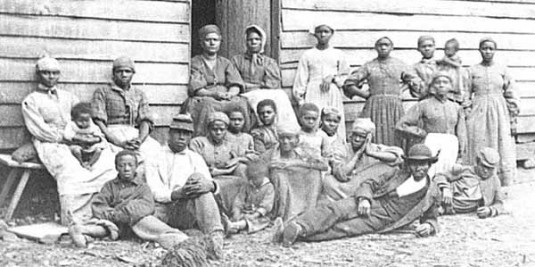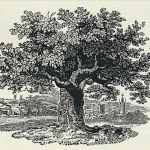This article by Egbert T. Bush answers some questions about the Bowne farm that were raised in the previous post, “Dr. Bowne’s Homestead.“1 Lora Olsen had pointed out that there were two houses on the property, one quite old, and one built in the mid 19th century. But it turns out there was a third house—one built for the slaves that lived on the farm.
E. T. Bush
Articles by Egbert T. Bush published in the Hunterdon Democrat
The Daybooks of Dr. Bowne
Recently I attended a workshop given by archivist Don Cornelius on the holdings of the Hunterdon County Historical Society. They are extensive, far more than I realized. Among them are the original daybooks of Dr. John Bowne of old Amwell Township, filled with the names of his patients and their treatment. These Daybooks are so important to genealogists that someone at the Historical Society has gone to the considerable effort of indexing the names into a card catalog, and—primitive as it may seem to be today—it’s a very useful genealogical tool for the time period of 1791 through 1857.
Much Mischief Was Blamed on a Witch
The Good Old People Could Identify Her and Tell of Her Doings
She Rode on a Broomstick
by Egbert T. Bush, Stockton, N.J.
published in the Hunterdon County Democrat, May 1, 1930
A Barn Raising Was A Big Event
Feeding Fifty Men Was Not Uncommon on Such an Occasion
Eatables in Great Abundance
by Egbert T. Bush, Stockton, N.J.
originally published by the Hunterdon Co. Democrat, July 24, 1930
Note: I have included the punctuation as it appeared in the original article, even though I disagree with the editor’s use of commas, and wonder if that was how Mr. Bush wrote it. Also, when Mr. Bush refers to “the young generation,” he means people born in the late-19th and early 20th-century. Mr. Bush was born in 1848.
Old Barns Were Built For The Ages
Processes of Lining, Scoring, Boring and Hewing Described
‘The Big Thrashing Floor’
by Egbert T. Bush, Stockton, N. J.
published in the Hunterdon County Democrat, July 17, 1930
There is no genealogy in this article; it is simply about how to build a barn.
“California” in Franklin Township
Elisha Warford
In his diary, Benjamin Ellicott made several references to his father-in-law, Elisha Warford. Warford is a legendary figure in the history of the Locktown-Croton vicinity, so it seems appropriate to publish Mr. Bush’s recollections of the man. He was a controversial figure, extremely wealthy, and extremely litigious. He never hesitated to take his debtors to court, as the papers in the Warford Collection at the Hunterdon County Historical Society will attest. Warford was a difficult personality that Mr. Bush managed to write about without casting aspersions. But then Egbert T. Bush was always a gentleman. As usual, I will take the liberty of making comments and annotations.
Slavery in Hunterdon

In the most recent issue of the Hunterdon Historical Newsletter, Lois Crane Williamson wrote an article titled “The Last Slave in Franklin Township.” It shows that slaves were still living in Hunterdon County long after the Gradual Emancipation Act of 1804 was signed. The last advertisement for a runaway slave to appear in the Hunterdon Gazette was published on February 14, 1838:
Lime and Trees and Other Things
First Trip to Delaware River Kilns an Experience for a Boy
Spoke Making a Lost Trade
by Egbert T. Bush, Stockton, N. J.
published in the Hunterdon Co. Democrat, April 21, 1932
 In recognition of the belated arrival of spring, I offer Mr. Bush’s tale of how farmers got lime for their fields in the mid 19th-century. And among those “Other Things,” Mr. Bush describes the business of spoke making.
In recognition of the belated arrival of spring, I offer Mr. Bush’s tale of how farmers got lime for their fields in the mid 19th-century. And among those “Other Things,” Mr. Bush describes the business of spoke making.
As our forests were cut off and the stumps rotted away, the land was found to be or soon to become more or less sour. The sorrels began to grow plentifully, especially the tall, reddish brown one that we called “horse sorrel.” That was later known as a sure indication that the land needed lime, tho in the earlier stages little was known about sour land or the indications, or even about lime as a sweetener. Such knowledge, like almost every other kind, grew gradually with experience and observation, until science took hold of such matters and showed us to be sometimes on the right track without knowing exactly why.
How Locktown Got Its Name
Back in February, I published an article on the cemetery connected with the Locktown Baptist church. Previously I have written about the Baptist congregation here as well as the Locktown Christian Church and its Cemetery. It seems appropriate now to include Mr. Bush’s own history of this neighborhood, which was published in the Hunterdon Democrat, on May 22, 1930. Along with the churches, Mr. Bush discusses the school house, the distillery and the Locktown Hotel, which began its life as a humble tavern, and also some of the old families, like the Chamberlins, Heaths, Lairs, Rittenhouses, Smiths and Suttons. Photographs in this article were provided by Paul Kurzenberger.